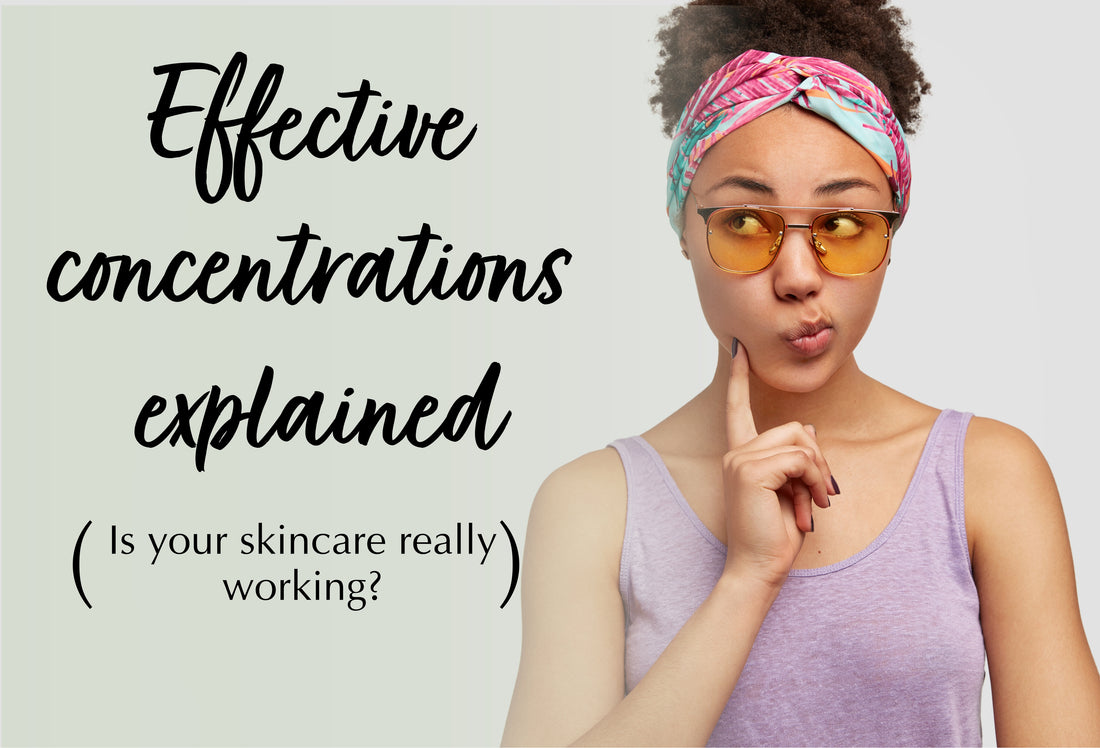
Is your skincare routine really working?
The answer is: Not Likely...Unless...
it has been formulated to contain beneficial ingredients at EFFECTIVE CONCENTRATIONS:
1–2-minute read
Effective Concentration: The percentage range of any active ingredient that is required to achieve benefit to the skin.
What does Effective Concentration mean for you?
The “Goldi-Locks Zone”
A skincare ingredient list may have an impressive list of beneficial active ingredients but are they in their effective concentrations? There are many ingredients out there (examples below) that have been generally accepted as compounds that affect beneficial biochemical change in the skin. These ingredients, however, must fall into a certain percentage range to be effective. This is what I refer to as the “Goldi-Locks Zone” and yes… I made that up… you're welcome. Too little of the ingredient and you don’t receive any benefits. Too much and it can have negative side effects.
So how do you know whether or not your face cream has any ingredients at effective concentrations?
Look at the front of the bottle. If you see an active ingredient listed with a percentage amount next to it, then you are holding a product that has an ingredient at an effective concentration. If you don’t see any ingredients listed on the front of the bottle…..Well then my dear there is a strong chance that you are holding in your hand a product that has ZERO active ingredients at effective concentrations. Most skin care products out there, including the $1k + ones, fall into what I call the “wet” category. These products attract moisture into the skin and trap it there… nothing else.
Yea, I felt a bit betrayed as well. (I did something about it though)
Here is a list of ingredients and the percentage range at which they are effective. These efficacies are widely accepted.
Hyaluronic Acid: Often used for its hydrating properties, effective concentrations typically range from 0.1% to 2%. At these levels, it can help retain moisture in the skin, giving it a plump and hydrated look.
Vitamin C (L-Ascorbic Acid): Known for its antioxidant and brightening properties, effective concentrations for L-Ascorbic Acid usually range from 10% to 20%. However, it's worth noting that Vitamin C can be irritating for some, so it's always best to patch-test any new product. Check out my tips for Vitamin C
Salicylic Acid: Commonly used for acne-prone skin, effective concentrations for over-the-counter products typically range from 0.5% to 2%. This beta hydroxy acid helps exfoliate the skin and unclog pores.
Niacinamide: This versatile ingredient, known for its ability to reduce inflammation, brighten skin, and strengthen the skin barrier, is often used at concentrations between 2% and 10%.
Peptides: These are chains of amino acids that can address various skin concerns, from wrinkles to loss of firmness. Effective concentrations can vary widely, but many products contain peptides at 1% to 3%.
Kojic Dipalmitate: Typically used in concentrations ranging from 1% to 5%. The exact concentration can vary based on the desired effect and the formulation's overall composition.
Tranexamic Acid: For topical skincare products, Tranexamic Acid is often formulated at concentrations between 2% and 5%. However, in certain clinical settings, higher concentrations might be used under professional guidance.
Alpha Arbutin: Commonly used in concentrations ranging from 0.2% to 2%. Higher concentrations can be used, but it's essential to ensure the product's stability and user tolerance.
MSM (Methylsulfonylmethane): In skincare formulations, MSM is typically used in concentrations ranging from 5% to 10%. However, the concentration can vary based on the product's intended purpose and the synergistic effects of other ingredients in the formulation.
Points to Remember:
Patch Test: Always patch-test a new product, especially if it contains active ingredients. This can help you identify any potential reactions before applying the product to your entire face.
Stability: Some ingredients, like Vitamin C, are notoriously unstable. Their effective concentration can diminish over time or when exposed to light and air. It's crucial to store such products correctly and note their shelf life.
Skin Tolerance: While there are general guidelines for effective concentrations, individual skin tolerance can vary. Some people might see benefits at the lower end of the concentration spectrum, while others might need a higher concentration. It's always a good idea to start with a lower concentration and gradually increase if needed.
Consultation: If you're unsure about the right concentration for your skin type or concern, it's always best to consult with a dermatologist or skincare professional. They can provide guidance tailored to your specific needs.
Understanding effective concentration is vital for anyone interested in skincare, whether you're formulating products or just choosing the best ones for your routine. By being informed about the ingredients and their optimal percentages, you can make better decisions for your skin's health and appearance. Remember, it's not just about having an ingredient in a product; it's about having the right amount of that ingredient to make a difference.
You may contact us with any questions you may have and if we don't have the answer, we will consult our network of skin care professionals and find it for you! (no but for real, we aren't going to google it).
And like our instagram page!
and I implore you to go and
Have yourself a quality day!
Mathew B Mayer

